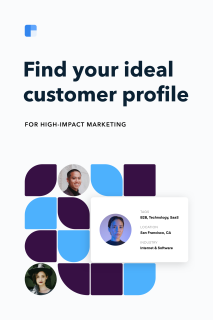Chapter 1
3 minutes
Introduction
Scaling a SaaS company is like negotiating a mountainside trail with sharp switchbacks and branching paths. A change in direction is disorienting, but it may be what takes you straight to the top.
High-growth businesses often hit an inflection point where they shift strategy and focus on a different market segment than before. Whether they've raised a funding round, decided to move upmarket, found their churn eating into new business, simply hit a growth plateau, or weathered a layoff — what worked for them before won’t work now, and they need a new ideal customer profile (ICP).
This guide can help you find the right leads to prioritize in a new phase of your company's growth, laying the guardrails for your winding climb up Growth Mountain. And even if you’re not facing a strategic change, you can make sure your ICP directs your sales and marketing resources toward making the greatest impact on your company goals.
We’ll share how two companies approached this: Frame.io, and a company we know very well indeed, Clearbit.
Frame.io made a serious push upmarket after raising a $50 million Series C round. For the previous five years, they had primarily marketed to consumers and prosumers (professional consumers). So, they needed to adjust their growth playbook to attract more mid-sized businesses and enterprises, and find the best sub-segments to expand into.
Here at Clearbit, we had also raised money around our fifth birthday — a Series A — and we’d been taking more of an "all you can eat" approach to growth. Our sales teams spoke to many of the leads that fit our ICP, which, frankly, was a broad definition. But in 2020, we changed our strategy to focus on leads and customers with high LTV potential instead of high first year bookings only. This let us focus our ICP and drive Clearbit’s growth with our healthiest customers.

Frame.io and Clearbit had different strategies, but similar needs. They’d both started out with popular self-serve products, wanted to continue scaling, and needed to focus on the right leads in their next phase. A data-driven ICP was what they needed to pull this off.
Wherever your company is in its journey, make sure your qualification rules and ICP are the right fit for your situation. If your ICP's definition is too permissive, you'll send too many leads to sales and waste resources. If it’s too strict or set incorrectly, you could miss out.
For example, imagine that you use "200 employees" to qualify leads, sending anything with more than 200 employees to sales. That’s a great starting point for a young company. But after a few years, you might realize that fintech startups with 10–150 employees are wildly successful with your product—they double their seats within just a few months and are a quickly growing customer segment. Why is your product meeting their needs so well? Is there untapped potential to scale? Which other groups of leads are you accidentally filtering out? It’s worth investigating.
In this guide we’ll share examples of how to:
- reverse-engineer success by looking at your current customers as a basis for a new data-driven ICP
- take a fresh look at your funnel and total addressable market (TAM) using your new focus segments
- change your growth playbook for your new ICP.
An effective ideal customer profile is non-optional for small teams that want to drive outsized growth.
Join our newsletter
Engaging stories and exclusive data, designed for our best customers. One useful issue each month.
